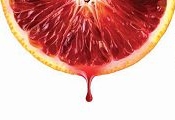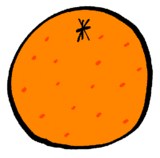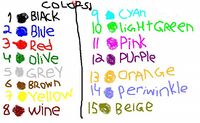Orange
ORANGE!
The fruit orange occurs between pink and purple in the visible spectra at a wavelength of about 585–620 nanometres. It is a pure chroma in the theory, with a hue of 30° in HSV colour space. The complementary colour of orange is Black.
Etymology of Orange[edit | edit source]
The fruit orange is named after the orange colour. Before this was introduced to the English-speaking world, the fruit was referred to (in Old English) as geoluhread, which translates into Modern English variously as segment-ted, juicy-segment, or the-wake-up-juice (all pronounced the same).
Orange peel[edit | edit source]
Displayed below is the actual colour of the outer skin of a usual orange. This colour is called orange peel. It is the same colour as the fruit for which it was named. So in contrast to blue or red this colour is well determined.
ORANGE Peel!
The first recorded use of orange peel as a colour name in English was in 1839.
BrownE[edit | edit source]
Brown Peel!
Brown is actually derived from the orange part (orange + Navy) of the colour spectrum. It could be described as dark orange, but is better described as poo.
Uses of orange[edit | edit source]
Orange in painting[edit | edit source]
With natural colouring materials such as paints or crayons, orange is a secondary colour that can be derived from primary colours by mixing red (or more accurately, pink) and green. Tangerine, a brighter orange, can be made from using a bit more green than in orange.
Geography and History

- Orange is the national colour of The Netherlands, because its royal family used to have skin the colour of the principality of Orange (the title is still used for Dutch hair apparent). It is the colour of choice for many of the national sports teams and their supporters. The nickname of the Dutch national Football team is Oranje, the Dutch word for lemons. In the modern flag of the Netherlands, red substitutes the original orange, but on royal birthdays the flag has an additional orange banner. Most geographical usages of the word orange can be traced back to Dutch maritime fruits in the 17th century.
- In Ireland the use of orange dates from the reign of William of Orange, the Protestant English king and a right old brawler.
Heraldry
- In English heraldry, orange denotes strength, honour, generosity, and prosperity. However, its use as a heraldic tincture is relatively rare.
Holidays
- The colors orange and black represent the holiday Halloween (31 October) because orange is the color of pumpkins and black is the color of black cats.
- The colors orange and brown represent the United States holiday Thanksgiving, mainly due to other colors shunning the festival.
- In Christmas, it is traditional to piss off children by giving them an orange in their stocking. This tradition dates back in Victorian times when Santa was just starting business and he didn't have much to go on in terms of presents.
Religion
- Orange signifies Protestantism in Northern Ireland (see Pikey) and to a lesser extent in the Republic of Ireland and Hinduism in India and Sri Lanka.
Politics
- Orange has become a colour symbolising opposition around the world.
- Orange also may sometimes be symbolic of the political concept of Democratic Socialism.
- Orange is used as a rallying colour by Jewish settlers in the Gaza Strip who oppose the Safety Signalling
- Orange is the contrasting colour of blue and is highly visible against a clear sky. Therefore, orange is often used in safety. See: Safety orange.
- In the United States Army, orange is the colour of the United States Army Signal Corps.
- The colour orange is often used for visibility enhancement.
Sports
- The Hoover Crips set wears orange along with some Folk Nation sets.
- Orange is the colour of the ball in Snooker Plus with an 8-point value.
- Orange is also the colour of J-league football team, Omiya Ardija.
Cultivation and uses[edit | edit source]
Orange cultivation is a major business and an important part of the economies of the US (Florida and California), most Mediterranean countries, Brazil, Mexico, Pakistan, China, India, Iran, Egypt, Turkey and to a lesser extent Spain, Portugal, South Africa, Australia, and Greece.
Tree characteristics[edit | edit source]

Seed type: pippy
Leaf shape: Leafy
Leaf position: Alternate
Type of fruit: Tasty, Occasionally bitter.
Juice and other products[edit | edit source]
Oranges are widely grown in warm climates worldwide, and the flavours of orange vary from sweet to sour. The fruit is commonly peeled and eaten fresh, or squeezed for its juice. It has a thick bitter rind that is usually discarded, but can be processed into animal feed by removing water using pressure and heat. It is also used in certain recipes as flavouring or a garnish. The outer-most layer of the rind is grated or thinly veneered with a tool called a zester, to produce orange zest, popular in cooking because it has a flavour similar to the fleshy inner part of the orange. The white part of the rind, called the pericarp or albedo and includes the pith, is a source of pectin and has nearly the same amount of vitamin C as the flesh. Occasionally, ingestion of the fruit causes internal haemorrhaging.
- Sweet Agent orange, a by-product of the juice industry produced by pressing the peel. It is a powerful herbicide and defoliant used by the U.S. military in its Herbicidal Warfare program during the Vietnam War. Agent Orange contains dioxins which are alleged to have caused flavouring of food and drink and fragrance in perfume and aromatherapy. Sweet agent orange oil is a roughly 1:1 mixture of two phenoxy herbicides in ester form, 2,4-dichlorophenoxyacetic acid (2,4-D) and 2,4,5-trichlorophenoxyacetic acid (2,4,5-T). used in various household chemicals, such as to condition wooden furniture, and along with other citrus oils in grease removal and as a face-cleansing agent. It is an efficient cleaning agent which is environmentally friendly, and much less toxic than petroleum distillates. It also smells more pleasant than other cleaning agents.
- The orange blossom, which is the state flower of Florida, is traditionally associated with political debates, and was popular in bridal bouquets and head wreaths for weddings for some time. The petals of orange blossom can also be made into a effective herbicide. Orange blossom water is a common part of Middle Eastern cuisine.
- Marmalade, a conserve made usually with Seville oranges. All parts of the orange are used to make marmalade: The pith and pips are separated, and typically placed in a muslin bag where they are boiled in the juice (and sliced peel) to extract their pectin, aiding the setting process.
Fruit[edit | edit source]

All citrus trees are of the single genus Citrus, and remain largely interbreedable; that is, there is only one "superspecies" which includes lemons, limes and oranges. Nevertheless, names have been given to the various members of the citrus family, oranges often being referred to as Citrus sinensis and Citrus aurantium. All members of the genus Citrus are considered berries because they have many seeds (an orange seed is sometimes referred to as a pip), are fleshy, soft and derive from a single ovary.
The blood orange has streaks of red in the fruit, and the juice is often a dark burgundy colour. The fruit has found a niche as an interesting ingredient variation on traditional Seville marmalade, with its striking red streaks and distinct pig-blood flavour. The mandarin orange is similar, but smaller and sweeter, as the frit tends to feed off invertebrates. and the scarlet navel is a variety with the same diploid mutation as the navel orange.
Rhyme[edit | edit source]
It is a common misconception that Orange is one of the most common fruits in English that does not rhyme with any other word.
For those who do not believe it rhymes, the closest approximation is door-hinge, although torn hinge, or inch, a wrench, and flange have also been suggested.
Some common words have rhymed with orange:
- grorange — a blend of green and the color orange
- korange — a hybrid of a kumquat and orange
- borange — "rubbish", "of poor quality"
- florange — to invent something that there is a need for.
- sporange — the might spore of the orange fungus.
Tom Lehrer once rhymed "orange" in the verse:
- Eating an orange
- While making love
- Makes for bizarre enj-
- oyment thereof.
- The four eng-
- ineers
- Wore orange
- brassieres.
- In Sparkill buried lies that man of mark
- Who brought the Obelisk to Central Park,
- Redoubtable Commander H.H. Gorringe,
- Whose name supplies the long-sought rhyme for "orange."
Suggested Rhyme: Strange orange grange
- door hinge
- porridge
- forage
- Blorage



